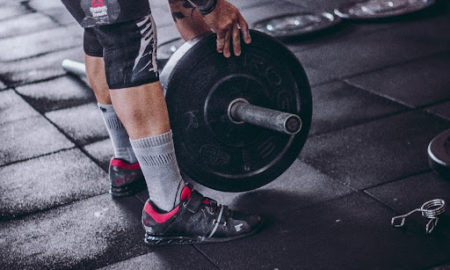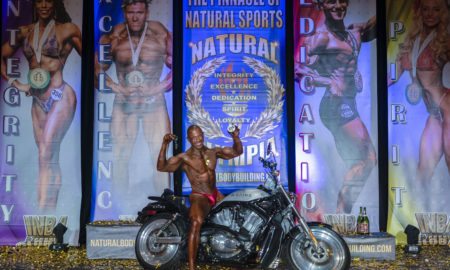Strip away all the supersecret, hardgainer’s-shirt-bursting biceps workouts of the pros, all the miracle supplements and the Bolivian fruit fly extract that’s guaranteed to add three inches to your arms, and bodybuilding is reduced to simple physics. Oh, sure, there’s a multimillion-dollar industry out there trying to tell you otherwise—that you can get great biceps by holding a weight that makes you shake, that you can get ripped and huge by swallowing a couple of pills and cutting your hair like Jay Cutler’s. Bull.
Simple Physics
It never fails. Every competitive bodybuilder I’ve ever interviewed on arm training has told me that the most prominent mistake he sees others making is poor form caused by an attempt to use too much weight. Want to see a bodybuilder laugh? Use bad form on arm work. If you need some pointers on what bad form is, listen to NPC superheavyweight Todd Jewell:
“Sometimes, precontest, when you’re feeling generally grumpy, you see people in the gym moving their elbows all over the place, using their delts as the primary working muscle with a nonexistent range of motion, and you want to walk over, grab the weight out of their hands and ask: ‘What are you doing?’ Then you just shake your head and laugh.”
The trick is to maintain proper form while moving enough weight to stimulate the muscle, which brings us right back to simple physics:
Intensity = Weight x Repetition
With enough intensity you stimulate a response—growth. A lot of it, you hope. Sometimes that growth comes easily. For example, take Todd, whose biceps grew so readily, he had to back off training them at one point.
“For about three years I stopped training biceps,” he reveals. “My biceps just grow like crazy.”
I know what you’re thinking: “Lucky him.” That type of propensity for growth, however, is what separates the top-tier bodybuilders from the rest of us. Still, even lifters with genetic advantages need to use good form. In fact, many of them rely on it.
Now, I can hear you listing multiple reasons why the workouts of top NPC and IFBB bodybuilders won’t work for someone who’s natural and has to use the five-pound neoprene dumbbells to avoid overtraining. Might I suggest that a lack of drugs isn’t what’s left you with 13-inch arms? Granted, your genetic potential might not be anywhere near 20 inches, but wouldn’t it be fun to see what it really is?
That said, my standard guarantee for arm-training articles applies: Even if you follow Todd’s advice to a tee, there is a 99.999 percent chance that your arms will look nothing like his after one, two or even three years.
Biceps
There’s really no mystery about good biceps training. Almost every bodybuilding magazine has at one time or another announced on its cover that you can “unlocked the secret of massive arms.” That the secret will involve curls, curls and more curls is almost a given. So not surprisingly, Todd Jewell’s base biceps workout looks like this:
Standing barbell curls
Reverse-grip cable curls
One-arm seated cable curls
“I always start with at least a 15-rep warmup on each exercise,” he says. “From there I just go by instinct. I never actually plan my sets and reps. I only plan which exercises I will do that day. Lately I have been doing some higher-rep sets at the end of my workout to pump as much blood into the muscle as possible.”
Todd’s base biceps routine is just a starting point. He always begins with standing barbell curls, but after that it’s open season.
“I’ll do isolated dumbbell curls, machine curls, cambered-bar curls—you name it,” he says. “The only things that stay the same are form and intensity.
“I’ve recently restarted training biceps,” Todd admits. “I’ve seen how guys with freaky bodyparts are getting noticed these days, so I decided why not?” His method for inducing growth is blood volume—specifically, using slightly lower weight at higher reps to allow the muscle to be gorged with blood before reaching ultimate fatigue. It’s the opposite of so-called high-intensity training but with equal intensity.
Todd ups his intensity by upping the number of repetitions he performs. Not only does that increase the blood flow to the muscle, but it also increases the total poundage he lifts on any given exercise. As you might suspect, form is his key concern.
“I see guys overtraining all the time, and they’re sitting around with puny arms,” he says. “If you up volume or up your weights and don’t have good form, you’re just wasting your time.”
In other words, increased intensity is important—but not at the expense of good form. If you add drop sets or X Reps or endurance sets at the end of each bodypart workout, make sure to maintain good form until the very end. There’s not much lost if you swing the weight up on reps 45 and 46, but if you’re hoisting it with your shoulders on reps 10 through 46, well, not so good.
Triceps
It’s easy to think of the triceps as the physique equivalent of the wingman. While the biceps walk home with the hot brunette in the bikini, the triceps gets stuck with her recently divorced friend who has violent thoughts toward the opposite sex. It’s easy to forget that, in reality, the triceps is the 6’5” 275-pound defensive lineman and the biceps is the punter. In fact, the triceps makes up two-thirds of the entire mass of the upper arm. So maybe it’s time some of the T-shirt-bursting street cred was passed along to the horseshoe muscle.
Here’s a typical triceps routine for Todd:
Smith-machine close-grip bench presses
Two-arm overhead rope extensions
One-arm rope pushdowns
Triceps training is just as important as working biceps to Todd. It’s also an area where he’s genetically inclined to grow. Since the triceps is a larger muscle group than the biceps, it can typically handle a heavier workload.
“I’m all over the place training triceps,” says Todd. “I do skull crushers and overhead dumbbell extensions—you name it.” One thing that doesn’t change is his attention to form. Todd’s credo is, If it works for one bodypart, it should work for all of them. So he gives the same consideration to technique when training triceps as he does biceps.
“Chest and back can do most of the work on triceps if you’re not careful,” he advises. “Just be sure not to roll the shoulders or hunch forward.”
Intensity
Ultimately, the responsibility for whether you reach your personal-potential arm development is yours. The key to growing a good set of arms is to tweak the intensity formula to work for you. Does your body respond to higher weights and lower reps? Then that’s the direction in which you should go. Conversely, if blood-volume training is giving you an advantage, adjust the formula accordingly. No matter how you approach your training, the right amount of intensity to use will almost always fall within a narrow range: right around more than what’s comfortable. After all, no one ever sparked growth of any type by staying in the comfort zone.
Editor’s note: Todd Jewell is an NPC national-level competitor. To contact him for guest posing, personal training or other inquiries [email protected]. IM
Here’s what Todd had to say about his future on the contest stage:
CC: How are your plans for 2010 coming along?
TJ: Real well. My family just moved back to our hometown [of Yakima, Washington], so we’ve been settling in and I’ve gotten back into training.CC: Any contests coming up?
TJ: Actually, I might take 2010 off to make improvements. One thing I’ve noticed is that I tend to look smaller at times than guys who are lighter than me. Take [the ’09 NPC] Nationals. During prejudging I was standing next to Cedric McMillan [the eventual overall winner]. He weighed in four pounds lighter than me, but he looked a lot bigger.CC: Wonder why.
TJ: I think it’s because I haven’t tried to have any real freaky bodyparts. I’ve always gone for a balanced, even look, but that’s not what’s getting noticed these days. That’s the reason I started training biceps again—so that they would get bigger.Plus the fact that it looks damn impressive onstage. I figure if I’ve got a bodypart that can be freaky, I’d better do whatever I can to make it freaky.
CC: What else are you working to bring up right now?
TJ: Legs and muscle separation. My muscles are “crammed in” if you will, so I’m really working on stretching the muscle fascia and bringing up the tie-ins and separation. Like I said, my goal is to look physically bigger onstage.CC: So when do you plan on competing?
TJ: To be honest, I really don’t know. I’d like to do the USA this year and the Nationals, but there’s this whole recession thing, and I still want to grow. I might end up waiting until the 2011 USA before I step onstage. The wife and I have to talk about it. —C.C.
















You must be logged in to post a comment Login